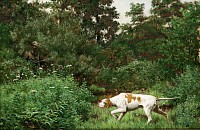BIOGRAPHY

John Martin Tracy, American (1843 – 1893)
J.M. Tracy was renowned in his lifetime as a painter of dogs, horses, and sporting scenes, but today he is one of the most elusive figures in American art. His obscurity is partially accounted for by the fact that his work seldom comes on the market. For reasons of pride and sentiment his paintings have remained largely in the families or clubs of the sportsmen who commissioned them.
Tracy was born near Rochester, Ohio, in 1843. His father, a preacher and abolitionist, was killed by mob violence in an anti-slavery uprising. His mother, Maria Conant Tracy, provided for her three children as a journalist. She was sent by her Cleveland paper to cover the Crystal Palace Exhibition in London in 1851. This determined individual, who had also studied medicine, was a pioneer on behalf of women's suffrage and was active in the Women's Christian Temperance movement.
Tracy grew up for the most part in the home of his grandmother, Orpha Conant, and was said to be a high-strung, hyper-sensitive, imaginative little boy. The school run by his Uncle John Lynch in Circleville prepared him for Oberlin College and Northwestern University, which he attended.
In 1861 he enlisted as a volunteer in the 19th Illinois Infantry, in which he attained the rank of lieutenant. The wartime stories he told his children in later years attest to a great amount of fraternizing between the Confederate and Union lines. In this way Tracy formed lifelong friendships with many Southerners.
It seems that he made the decision to be an artist during the war. After discharge he worked as a school teacher and laborer in the orchards of southern Illinois until he had sufficient funds to go to the Ecole des Beaux Arts in Paris. On his return to the United States, probably no more than a year later, he struck out for California and painted the scenery there. These subjects, according to his daughter, were in the grand style and on the grand scale which was then making the name of Albert Bierstadt a household term.
Between 1872 and 1873 Tracy had a studio in Chicago, but in the latter year he went again to Paris. He studied at a school tucked behind the Ecole which emphasized rigorous training in drawing from memory, which certainly proved to be a valuable skill when he later turned to painting field trial subjects. On this trip he fell in love with and married Melanie Guillemin, sister of the sculptor Emile Guillemin. Tracy's full-length portrait of her was exhibited in the Salon of 1874.
His interest seems to have changed at this time from landscape to portraiture. When he returned to the United States he opened a portrait studio in St. Louis, but perhaps feeling the effects of the daguerreotype which hindered most portraitists at one time or another in the nineteenth century, he moved to Greenwich, Connecticut in 1881 and began to paint sporting subjects. He purchased an historic farmhouse and filled it with Revolutionary War relics as well as colonial furniture, becoming one of the first collectors of early American antiques. Tracy's immense popularity as a painter of sporting subjects is due in large part to his accuracy. He was often called upon to do portraits of dogs, two of which belong to the American Kennel Club.
Perhaps because he suffered from a lingering illness, he moved to the milder climate of Ocean Springs, Mississippi, in the late 1880s or early 90s. He died at Ocean Springs in his forty-ninth year, and he was survived by his wife and three children. When he died, Tracy left on his easel "Candidates for the Horse Show", an ambitious canvas measuring four by eleven feet.
